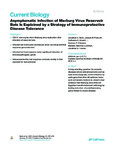Asymptomatic Infection of Marburg Virus Reservoir Bats Is Explained by a Strategy of Immunoprotective Disease Tolerance
Guito, Jonathan C.
Prescott, Joseph B.
Arnold, Catherine E.
Amman, Brian R.
Schuh, Amy J.
Spengler, Jessica R.
Sealy, Tara K.
Harmon, Jessica R.
Coleman-McCray, JoAnn D.
Kulcsar, Kirsten A.
Nagle, Elyse R.
Kumar, Raina
Palacios, Gustavo
Sanchez-Lockhart, Mariano
Towner, Jonathan S.
Marburg virus (MARV) is among the most virulent pathogens of primates, including humans. Contributors to severe MARV disease include immune response suppression and inflammatory gene dysregulation (“cytokine storm”), leading to systemic damage and often death. Conversely, MARV causes little to no clinical disease in its reservoir host, the Egyptian rousette bat (ERB). Previous genomic and in vitro data suggest that a tolerant ERB immune response may underlie MARV avirulence, but no significant examination of this response in vivo yet exists. Here, using colony-bred ERBs inoculated with a bat isolate of MARV, we use species-specific antibodies and an immune gene probe array (NanoString) to temporally characterize the transcriptional host response at sites of MARV replication relevant to primate pathogenesis and immunity, including CD14+ monocytes/macrophages, critical immune response mediators, primary MARV targets, and skin at the inoculation site, where highest viral loads and initial engagement of antiviral defenses are expected. Our analysis shows that ERBs upregulate canonical antiviral genes typical of mammalian systems, such as ISG15, IFIT1, and OAS3, yet demonstrate a remarkable lack of significant induction of proinflammatory genes classically implicated in primate filoviral pathogenesis, including CCL8, FAS, and IL6. Together, these findings offer the first in vivo functional evidence for disease tolerance as an immunological mechanism by which the bat reservoir asymptomatically hosts MARV. More broadly, these data highlight factors determining disparate outcomes between reservoir and spillover hosts and defensive strategies likely utilized by bat hosts of other emerging pathogens, knowledge that may guide development of effective antiviral therapies.
Dateien zu dieser Publikation

